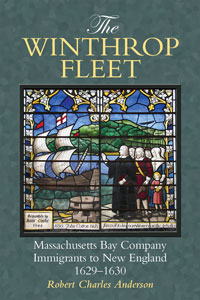In case you were wondering, American Ancestors’ Great Migration Study Project continues to add new research to uncover the details of immigrants who came to New England between 1636 and 1638. NEHGS will publish a first volume by Ian Watson in early 2023 that will contain letters A-Be for these years, and research will continue for the foreseeable future to cover those who arrived through the year 1640.
[Editor’s note: This blog post originally appeared in Vita Brevis on 21 April 2014.]
 The activities of the Massachusetts Bay Company in 1629-30 were uniformly organized from the top down. The Company either purchased or hired the vessels to carry the passengers and provisions. The passengers themselves, and especially the critically important professionals such as ministers and soldiers, were recruited by the Company leaders.
The activities of the Massachusetts Bay Company in 1629-30 were uniformly organized from the top down. The Company either purchased or hired the vessels to carry the passengers and provisions. The passengers themselves, and especially the critically important professionals such as ministers and soldiers, were recruited by the Company leaders.
Yet this phase of the migration was brief, as most of the merchants involved found the enterprises for which all this activity was expended to be losing propositions and allowed their New England plantations to disperse, some almost immediately and most by the middle of the next decade. The influence of those leaders of the Massachusetts Bay Company who remained behind in England quickly faded away, and by 1632 the top-down direction of the migration process was essentially at an end. Continue reading ICYMI: The Great Migration: Top-down, bottom-up




